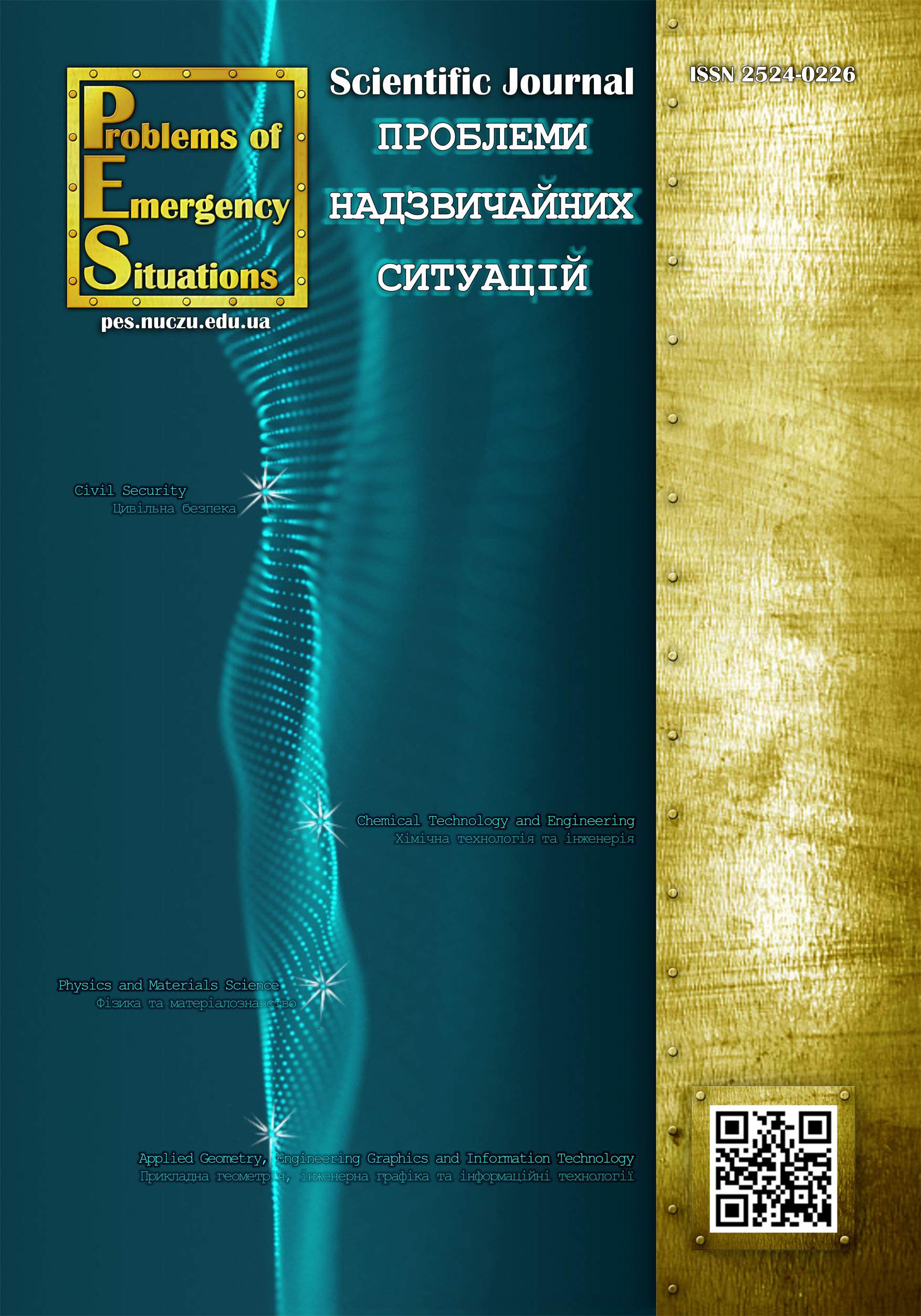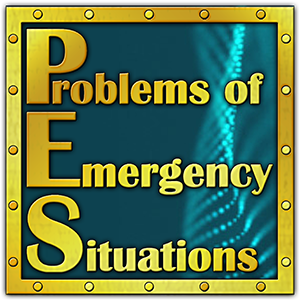Fire extinguishing development directions for liquids based on the foam glass primary layer
Tregubov Dmytro
National University of Civil Protection of Ukraine
https://orcid.org/0000-0003-1821-822X
Kireev Oleksandr
National University of Civil Protection of Ukraine
https://orcid.org/0000-0002-8819-3999
Kyazim Kyazimov
Academy of the Ministry of Emergency Situations
http://orcid.org/0000-0003-0790-9770
Trefilova Larisa
National University of Civil Protection of Ukraine
http://orcid.org/0000-0001-8939-6491
Slepuzhnikov Yevhen
National University of Civil Protection of Ukraine
https://orcid.org/0000-0002-5449-3512
Vavreniuk Sergei
National University of Civil Protection of Ukraine
http://orcid.org/0000-0002-6396-9906
DOI: https://doi.org/10.52363/2524-0226-2024-40-13
Keywords: fire extinguishing, flammable liquid, cluster, foam glass, buoyancy, isolation, cooling, gel, consumption
Аnnotation
The combustible liquid modulating parameter was established to predict the foam glass fire-extinguishing layer as the primary means for liquids ensuring reliable fire extinguishing in combination with other fire-extinguishing means. The formation peculiarities and buoyancy indicators of dry and wet foam glass in polar and non-polar liquids (alkanes and alcohols) were investigated. It is shown that the foam glass buoyancy increases with an increase in the liquid density. The foam glass buoyancy in polar and non-polar liquids was described depending on the liquid density by an approximate linear dependence separately for dry and wet foam glass. The deviation from the linear trend is explained by the foam glass different wettability, some alcohols water solubility, and liquid mixtures peculiarities. The buoyancy relation with flash point was established, which works separately for n-alkanes, n-alcohols and glycols, which was described mathematically. A formula was developed to describe the relationship between flash temperatures and the liquids density. Correlations with a fire-extinguishing layer of dry foam glass for molar mass, molecule or cluster length, stoichiometric combustion reaction coefficient, burning rate on a free surface, density, flash point, boiling point, autoignition temperature were studied. The forecasting possibility the dry foam glass fire-extinguishing layer based on the description of flammable liquids clusters has been established. Mathematical dependences were obtained for the dry foam glass fire-extinguishing layer depending on the expected clusters length in the liquid and a similar dependence for flash points. The conditions for effective extinguishing of alcohols and alkanes with dry foam glass have been determined. Different modes of extinguishing hydrocarbons with flash temperatures tfp<28 оС and tfp>28 оС are recommended, based on the primary layer of 6 cm of wet foam glass with a fraction of 1.0–1.5 cm, with the possibility of finalizing the extinguishing, if necessary, with an inorganic gel by spraying components with an application rate of 0.2 g/cm2.
References
- Trehubov, D. H., Dadashov, I. F., Minska, N. V., Hapon, Yu. K., Chyrkina- Kharlamova, M. А. (2024). Fizyko-khimichni osnovy rozvytku ta hasinnya pozhezh horyuchykh ridyn. Kh.: NUTSZ Ukrayiny, 216. Available at: http://repositsc.nuczu.
edu.ua/handle/ 123456789/19111 - DSTU B V.2.6-183:2011. (2012). Rezervuary vertykalʹni tsylindrychni stalevi dlya nafty ta naftoproduktiv: Zahalʹni tekhnichni umovy. [Chynnyy vid 2012-10-01]. Kyyiv: Minrehion Ukrayiny. Available at: https://zakon.isu.net.ua/sites/default/ files/pdf/rezervuari_vertikalni_cilindrich-3-476789.pdf
- Dadashov, I. F., Tregubov, D. G., Senchihin, Yu. N., Kireev, A. A. (2018). Improvements of extinguishing of oil products. Scientific Bulletin of Construction, 94(4), 238–249. doi: 10.29295/2311‒7257‒2018‒94‒4‒238‒249
- Dadashov, I. F., Kiryeyev, O. O., Trehubov, D. H., Tarakhno, O. V. (2021). Hasinnya horyuchykh ridyn tverdymy porystymy materialamy ta heleutvoryuyuchymy systemamy. Kh.: NUTSZU, 240. Available at: http://repositsc.nuczu.edu.ua/handle/ 123456789/14033
- Tregubov, D., Dadashov, I., Nuianzin, V., Khrystych, O., Minska, N. (2023). Relationship Between Properties of Floating Systems and Flammable Liquids in the Stopping Their Burning Technology. Key Engineering Materials, 954, 145–155. doi: 10.4028/p-krzrd9
- Loboichenko, V., Strelets, V., Gurbanova, M., Morozov, A., Kovalov, P., Shevchenko, R., Kovalova, T., Ponomarenko, R. (2019). Review of Environmental Characteristics of Fire Extinguishing Substances of Different Composition used for Fires Extinguishing of Various Classes. Journal of Engineering and Applied Sciences, 14, 5925–5941. doi: 10.36478/jeasci.2019.5925.5941
- Zhi, H., Bao, Y., Wang, L., Mi, Y. (2020). Extinguishing performance of alcohol-resistant firefighting foams on polar flammable liquid fires. Journal of Fire Sciences, 38(1), 53–74. doi:10.1177/0734904119893732
- Zarzyka, I., Majda, D. (2017). Thermogravimetric and qualitative analysis of thermal decomposition characteristics of polyurethane foams based on polyols with carbamide or oxamide, borate. Polymer International, 66(11), 1675–1683. doi: 10.1002/pi.5
- Balanyuk, V., Kozyar, N., Kopystynskyi, Y., Kravchenko, A. (2018). Extinguishing fires of alcohols and their mixtures. Fire Safety, (33), 5–9. doi: 10.32447/
20786662.33.2018.01 - Balanyuk, V., Kozyar, N., Garasyumyk, O. (2016). Study of fire–extinguishing efficiency of environmentally friendly binary aerosol-nitrogen mixtures. Eastern-European Journal of Enterprise Technologies. Technical science, 3/10(81), 4–11. doi: 10.15587/1729-4061.2016.72399
- Balanyuk, V., Kravchenko, A., Hаrasymyuk, O. (2021). Reducing the intensity of thermal radiation at the sublayer extinguishing of alcohols by ecologically acceptable aerosols. Eastern-european journal of enterprise technologies. Technical science, 1/10(109), 37–44. doi: 10.15587/1729-4061.2021.225216
- Korolov, R., Kovalyshyn, V., Shtajn, В. (2017). Analysis of methods for extinguishing fires in reservoirs with oil products by a combined method. ScienceRise, 6(35), 41–50. doi: 10.15587/2313-8416.2017.104613
- Balanyuk, V., Myroshkin, V., Kopystinsky, Y., Hirskyi, O., Gerasimiuk, O. (2022). Comparison of fire extinguishing substances for extinguishing fires of flammable liquids. Fire Safety, 41, 12–19. doi: 10.32447/20786662.41.2022.02
- Tianwei, Zh., Cunwei, Zh., Hao, L., Zhiyue, H. (2020). Experimental investigation of novel dry liquids with aqueous potassium Solution@Nano-SiO2 for the suppression of liquid fuel fires: рreparation, application, and stability. Fire Safety Journal, 115, 103144. doi: 10.1016/j.firesaf.2020.103144
- Shi, B., Zhou, F. (2016). Fire extinguishment behaviors of liquid fuel using liquid nitrogen jet. Process Safety Progress, 35(4), 407–413. doi: 10.1002/prs.11815
- Khrystych, V. V., Malyarov, M. V., Bondarenko, S. M. (2016). Suchasni sposoby pidvyshchennya efektyvnosti hasinnya pozhezhi rozporoshenoyu vodoyu. Problemy pozharnoy bezopasnosty, 40. 201–205. Available at: http://repositsc.
nuczu.edu.ua/handle/123456789/2198 - Dubinin, D., Korytchenko, K., Lisnyak, A., Hrytsyna, I., Trigub, V. (2018). Improving the installation for fire extinguishing with finelydispersed water. Eastern-European J. of Ent. Techn, 2(10–92), 38–43. doi: 10.15587/1729-4061.2018.127865
- Karvatska, M., Lavreniuk, O., Mykhalichko, B. (2023). Current status and directions for the improvement of aqueous fire-extinguishing agents. Scien. Bulletin: Сivil Protection and Fire Safety, 1(15), 92–100. doi: 10.33269/nvcz.2023.1(15).92-100
- Abdulrahman, S., Chetehouna, K., Cablé, A., Skreiberg, О., Kadoche, M. (2021). A review on fire suppression by fire sprinklers. Review on fire suppression by fire sprinklers. Journal of Fire Sciences, 39(6), 512–551. doi: 10.1177/07349041211013698
- Lu, J., Liang, P., Chen, B., Wu, C., Zhou, T. (2019). Investigation of the Fire-Extinguishing Performance of Water Mist with Various Additives on Typical Pool Fires. Combustion S. and Techn, 192(4), 592–609. doi: 10.1080/00102202.
2019.1584798 - Abramov, Y., Kolomiiets, V., Sobyna, V. (2023). Models of fire extinguishing when flammable liquid combustion. Municipal economy of cities, 4, 194–198. doi: 10.33042/2522-1809-2023-4-178-194-198
- Chernukha, A., Teslenko, A., Kovaliov, P., Bezuglov, O. (2020). Mathematical modeling of fire-proof efficiency of coatings based on silicate composition. Materials Science Forum, 1006, 70–75. doi: 10.4028/www.scientific.net/MSF.1006.70
- Abramov, Y., Basmanov, O., Salamov, J., Mikhayluk, A., Yashchenko, O. (2019). Developing a model of tank cooling by water jets from hydraulic monitors under conditions of fire. Eastern-European Journal of Enterprise Technologies, 1(10–97), 14–20. doi: 10.15587/1729-4061.2019.154669
- Makarenko, V., Kireev, A., Tregubov, D., Chirkina, M. (2021). Investigation of fire extinguishing properties of binary layers of lightweight porous materials. Problems of Emergency Situations, 33, 235–244. doi: 10.52363/2524-0226-2021-33-18
- Jelаgin, G., Кutsеnко, М., Аlекsееv, А., Nuianzin, A., Nеsеn, I. (2022). Extinguishing media for spilled flammable liquids. The scientific heritage, 84(1), 15–25. doi: 10.24412/9215-0365-2022-84-1-15-25
- Tregubov, D., Trefilova L., Slepuzhnikov, E., Sokolov, D., Trehubova, F. (2023). Correlation of properties in hydrocarbons homologous series. Problems of Emergency Situations, 2(38), 96–118. doi: 10.52363/2524-0226-2023-38-7
- Tregubov, D., Trefilova L., Minska N., Hapon Yu., Sokolov, D. (2024). Nonlinearities correlation of n-alkanes and n-alcohols physicochemical properties. Problems of Emergency Situations, 1(39),4–24. doi: 10.52363/2524-0226-2024-39-1
- Tregubov, D., Slepuzhnikov, E., Chyrkina, M., Maiboroda, A. (2023). Cluster Mechanism of the Explosive Processes Initiation in the Matter. Key Engineering Materials, 952, 131–142. doi: 10.4028/p-lZz2Hq
- Glassman, I., Yetter, R. A., Glumac, N. G. (2014). Combustion. London: Elsevier. doi: 10.1016/C2011-0-05402-9
- Tregubov, D., Tarakhno, O., Sokolov, D., Trehubova, F. (2021). The identification of hydrocarbons cluster structure by melting point. Problems of Emergency Situations, 34, 94–109. doi: 10.52363/2524-0226-2021-34-7
- PubChem. Compound summary. Available at: https://pubchem.
ncbi.nlm.nih.gov/ - Tregubov, D., Tarakhno, O., Deineka, V., Trehubova, F. (2022). Oscillation and Stepwise of Hydrocarbon Melting Temperatures as a Marker of their Cluster Structure. Solid State Phenomena, 334, 124–130. doi: 10.4028/p-3751s3
- Doroshenko, I. Yu. (2017). Spectroscopic study of cluster structure of n-hexanol trapped in an argon matrix. Low Temperature Physics, 3(6), 919–926. doi: 10.1063/1.4985983














